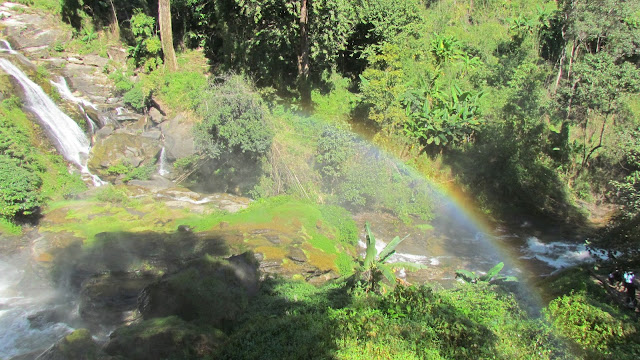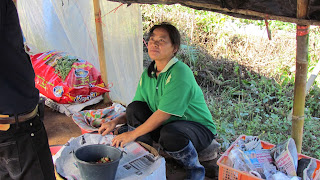December 20, 2016
Mick and June joined us for breakfast, then we went our separate ways. Our day was orchestrated by Untouched Thailand, taking us southwest of Chiang Mai to Doi Inthanon National Park. But our first stop of the day was Wiang Kum Kam - from Wikipedia:
Wiang Kum Kam is an ancient city (Thai: เวียง, wiang, meaning "walled city") located ... around 1.9 mi south of the southeastern corner of Chiang Mai's city centre....built by King Mangrai around the latter part of the 13th century. The city was established as a new capital by the King after his victory over the Mon people... Due to repeated flooding, a new capital, Chiang Mai, was built a few years later.Just a few original stones and bricks were interspersed with new bricks, but the outlines of the original structures are plain to see. The area didn't seem to get much attention - no entrance fee, and very little in the way of signage. Much of the ancient city appears to currently be used for worship. Religious practices in Thailand often combine modern Buddhism or Hinduism with ancient Animism beliefs, such as the worship of spirits. Animism attributes a soul to objects, so many believe these ancient objects and places have souls or house spirits.
The old city was lost from history for many years after Chiang Mai was conquered by the Burmese in 1558. There is a presumption that (Wiang Kum Kam) was seriously flooded... and was finally abandoned. In 1984... (they) discovered remnants of the old city.
 |
| Buddhist statues are often draped in gold fabric |
We then visited the Thai Hmong community market, where the local Hmong people plied their wares, mostly fresh and dried fruits, and bottles of fruit juices. It was such a colorful place, with the beautiful faces and dress of the Hmong. Many were young mothers with babies strapped to their backs, others were the elders whose faces belied their years of hard work and fresh air.
 |
| The colors! |
The next stop was just a little lot on the roadside, where we met up with a local guide. The mountain trek is through their land, and it is the locals who maintain the route. No one is allowed on the trail without paying a local guide for his services, so we had two guides for our walk down the scenic mountainside.
 |
| "Do not cast every garbages" |
 |
| PVC pipes carry water down the mountain along the trail |
 |
| Strawberry fields forever... |
We passed coffee plants growing under the shade of larger trees - the beans were not yet ripe, although we did spot a few isolated splotches of bright red.
 |
| I think this is a Giant Golden Orb Weaver - one of the biggest spiders in the world, up to 20 cm across! |
Our two-hour trek concluded in Mae Klang Luang, home of the White Karen hill tribe, one of many Karen tribes who immigrated into northern Thailand from Burma. This tribe is separate from the "long neck" karens, or kayans, who wear brass rings around their necks, making them appear longer than natural. In actuality, the clavicles are deformed by the rings. We had the option of visiting the long neck village, but it just didn't feel right - a little too much like a sideshow.
 |
| Pictures from friends who visited the "long-neck" Karens village |
Thankfully, our driver, Frank, met us here, (he's the one grinding the coffee) and we enjoyed a relaxing drive back to the hotel, getting a little taste of rush hour traffic as we came back into the city. Mick and June joined us in the hotel lounge for drinks and some Chinese checkers. Tomorrow we would leave Chiang Mai and drive south to the old capital city of Sukhothai.
(Big thank-you to Tim for his excellent camera work!)












































































No comments:
Post a Comment
Thanks for reading!